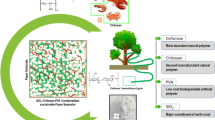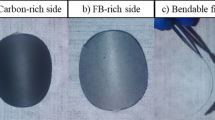Abstract
Today most of commercial Li-ion batteries (LIBs) are manufactured using toxic solvents and synthetic polymer binders. In order to lower the cost and the environmental impact of LIBs an effort must be made to identify low-cost and environmentally friendly materials and processes. In this work, flexible, self-standing and easily recyclable LiFePO4 cathodes are obtained using cellulose fibers as biosourced binder and a quick, aqueous filtration process, easily upscalable capitalizing the well-established papermaking know-how. The obtained paper-cathodes show very good mechanical properties, with Young’s modulus as high as 100 MPa, discharge capacity values up to 110 mAh g−1 and very good cycling performances, comparable with conventional polymer-bonded LiFePO4 cathodes. Moreover, a complete paper-cell, constituted by a paper-cathode, a paper-separator and a paper-anode is presented, showing good cycling performances in terms of specific capacity, efficiency and stability.







Similar content being viewed by others
References
Abad E, Zampolli S, Marco S et al (2007) Flexible tag microlab development: gas sensors integration in RFID flexible tags for food logistic. Sensor Actuat B-Chem 127:2–7. doi:https://doi.org/10.1016/j.snb.2007.07.007
Anderson RE, Guan J, Ricard M et al (2010) Multifunctional single-walled carbon nanotube–cellulose composite paper. J Mater Chem 20:2400. doi:https://doi.org/10.1039/B924260K
Archuleta MM (1995) Toxicity of materials used in the manufacture of lithium batteries. J Power Sour 54:138–142. doi:https://doi.org/10.1016/0378-7753(94)02054-7
Bodoardo S, Gerbaldi C, Meligrana G, et al (2009) Optimisation of some parameters for the preparation of nanostructured LiFePO4/C cathode. Ionics 15:19–26
Buqa H, Holzapfel M, Krumeich F et al (2006) Study of styrene butadiene rubber and sodium methyl cellulose as binder for negative electrodes in lithium-ion batteries. J Power Sour 161:617–622. doi:https://doi.org/10.1016/j.jpowsour.2006.03.073
Chen Z, Christensen L, Dahn JR (2003) Comparison of PVDF and PVDF-TFE-P as binders for electrode materials showing large volume changes in lithium-ion batteries. J Electrochem Soc 150:A1073–A1078. doi:https://doi.org/10.1149/1.1586922
Chung IJ, Kang I (2009) Flexible display technology—opportunity and challenges to new business application. Mol Cryst Liq Cryst 507:1–17. doi:https://doi.org/10.1080/15421400903047950
Daniel C (2008) Materials and processing for lithium-ion batteries. JOM 60:43–48. doi:https://doi.org/10.1007/s11837-008-0116-x
Darragh KV, Ertell CA (2001) Aluminum sulfate and alums. Encyclopedia of Chemical Technology
Dewulf J, Van der Vorst G, Denturck K et al (2010) Recycling rechargeable lithium ion batteries: critical analysis of natural resource savings. Conserv Recycl 54:229–234. doi:https://doi.org/10.1016/j.resconrec.2009.08.004
Dunne L, Ashdown S, Smyth B (2005) Expanding garment functionality through embedded electronic technology. JTATM 4:1–11
Etacheri V, Marom R, Elazari R et al (2011) Challenges in the development of advanced Li-ion batteries: a review. Energy Environ Sci 4:3243–3262. doi:https://doi.org/10.1039/C1EE01598B
Franger S, Le Cras F, Bourbon C, Rouault H (2003) Comparison between different LiFePO4 synthesis routes and their influence on its physico-chemical properties. J Power Sour 119–121:252–257. doi:https://doi.org/10.1016/S0378-7753(03)00242-8
Ghannam MT, Esmail MN (1997) Rheological properties of carboxymethyl cellulose. J Appl Polym Sci 64:289–301. doi:https://doi.org/10.1002/(SICI)1097-4628(19970411)64:2<289:AID-APP9>3.0.CO;2-N
Howard WF, Spotnitz RM (2007) Theoretical evaluation of high-energy lithium metal phosphate cathode materials in Li-ion batteries. J Power Sour 165:887–891
Hu L, Choi JW, Yang Y et al (2009) Highly conductive paper for energy-storage devices. Proc Natl Acad Sci 106:21490–21494
Hu L, Wu H, Cui Y (2010) Printed energy storage devices by integration of electrodes and separators into single sheets of paper. Appl Phys Lett 96:183502–183502–3
Hu L, La Mantia F, Wu H et al (2011) Lithium-ion textile batteries with large areal mass loading. Adv Energ Mater 1:1012–1017
Hubbe M, Wang F (2004) Charge-related measurements: a reappraisal. part 2: fibre-pad streaming potential. Paper Technol 45:27–34
Jabbour L, Gerbaldi C, Chaussy D et al (2010) Microfibrillated cellulose–graphite nanocomposites for highly flexible paper-like Li-ion battery electrodes. J Mater Chem 20:7344–7347
Jabbour L, Destro M, Gerbaldi C et al (2012) Aqueous processing of cellulose based paper-anodes for flexible Li-ion batteries. J Mater Chem 22:3227–3233
Kim GT, Jeong SS, Joost M et al (2011) Use of natural binders and ionic liquid electrolytes for greener and safer lithium-ion batteries. J Power Sour 196:2187–2194
Lee JH, Kim JS, Kim YC et al (2008a) Dispersion properties of aqueous-based LiFePO4 pastes and their electrochemical performance for lithium batteries. Ultramicroscopy 108:1256–1259
Lee JH, Kim JS, Kim YC et al (2008b) Effect of carboxymethyl cellulose on aqueous processing of LiFePO4 cathodes and their electrochemical performance. Electrochem Solid State 11:A175
Li J, Lewis RB, Dahn JR (2007) Sodium carboxymethyl cellulose. Electrochem Solid-State Lett 10:A17–A20
Li Z, Zhang D, Yang F (2009) Developments of lithium-ion batteries and challenges of LiFePO4 as one promising cathode material. J Mater Sci 44:2435–2443
Li J, Klöpsch R, Nowak M et al (2011) Investigations on cellulose-based high voltage composite cathodes for lithium ion batteries. J Power Sour 196:7687
Liimatainen H, Haavisto S, Haapala A, Niinimäki J (2009) Influence of adsorbed and dissolved carboxtmethyl cellulose on fibre suspension dispersing, dewaterability and fines retention. Bioresources 4:321–340
Lux SF, Schappacher F, Balducci A et al (2010) Low cost, environmentally benign binders for lithium-ion batteries. J Electrochem Soc 157:A320–A325
Maleki H, Deng G, Kerzhner-Haller I et al (2000) Thermal stability studies of binder materials in anodes for lithium-ion batteries. J Electrochem Soc 147:4470–4475
Markevich E, Salitra G, Aurbach D (2005) Influence of the PVdF binder on the stability of LiCoO2 electrodes. Electrochem Commun 7:1298–1304
Meligrana G, Gerbaldi C, Tuel A et al (2006) Hydrothermal synthesis of high surface LiFePO4 powders as cathode for Li-ion cells. J Power Sour 160:516–522
Meoli D, May-Plumlee T (2002) Interactive electronic textile development: a review of technologies. JTATM 2:1–12
Nagaura T, Tozawa K (1990) Lithium ion rechargeable battery. Prog Batterieis Sol Cells 9:209–217
Nnorom IC, Osibanjo O (2009) Heavy metal characterization of waste portable rechargeable batteries used in mobile phones. IJEST 6:641–650
Nyström G, Mihranyan A, Razaq A et al (2010) A nanocellulose polypyrrole composite based on microfibrillated cellulose from wood. J Phys Chem B 114:4178–4182
Padhi AK (1997) Phospho-olivines as positive-electrode materials for rechargeable lithium batteries. J Electrochem Soc 144:1188
Patil A, Patil V, Wook Shin D et al (2008) Issue and challenges facing rechargeable thin film lithium batteries. Mater Res Bull 43:1913–1942
Pushparaj VL, Shaijumon MM, Kumar A et al (2007) Flexible energy storage devices based on nanocomposite paper. Proc Natl Acad Sci 104:13574–13577
Scrosati B (2011) History of lithium batteries. J Solid State Electrochem 15:1623–1630
Scrosati B, Garche J (2010) Lithium batteries: status, prospects and future. J Power Sour 195:2419–2430
Takahashi M, Tobishima S, Takei K, Sakurai Y (2002) Reaction behavior of LiFePO4 as a cathode material for rechargeable lithium batteries. Solid State Ion 148:283–289
Whittingham MS (2004) Lithium batteries and cathode materials. Chem Rev 104:4271–4302
Xie L, Zhao L, Wan J et al (2012) The electrochemical performance of carboxymethyl cellulose lithium as a binding material for anthraquinone cathodes in lithium batteries. J Electrochem Soc 159:A499–A505
Xu J, Thomas HR, Francis RW et al (2008) A review of processes and technologies for the recycling of lithium-ion secondary batteries. J Power Sour 177:512–527
Yang L, Rida A, Vyas R, Tentzeris MM (2007) RFID tag and RF structures on a paper substrate using inkjet-printing technology. IEEE Trans Microw Theory Tech 55:2894–2901
Yoshio M, Brodd RJ, Kozawa A (2009) Lithium-ion batteries: science and technologies. Springer, New York
Zhang WJ (2011) Structure and performance of LiFePO4 cathode materials: a review. J Power Sour 196:2962–2970
Zhang SS, Jow TR (2002) Aluminum corrosion in electrolyte of Li-ion battery. J Power Sour 109:458–464
Zhang SS, Allen JL, Xu K, Jow TR (2005) Optimization of reaction condition for solid-state synthesis of LiFePO4-C composite cathodes. J Power Sour 147:234–240
Acknowledgments
This work was supported by Ministere de l’Enseignement Superieur et de la Recherche (MESR) grant.
Author information
Authors and Affiliations
Corresponding author
Rights and permissions
About this article
Cite this article
Jabbour, L., Destro, M., Chaussy, D. et al. Flexible cellulose/LiFePO4 paper-cathodes: toward eco-friendly all-paper Li-ion batteries. Cellulose 20, 571–582 (2013). https://doi.org/10.1007/s10570-012-9834-x
Received:
Accepted:
Published:
Issue Date:
DOI: https://doi.org/10.1007/s10570-012-9834-x




